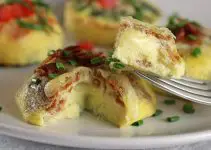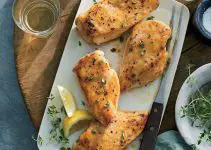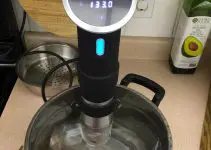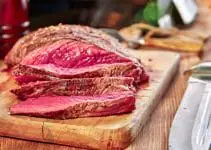Table of Contents
One of the most critical, and often under looked part of the sous vide cooking process is actually searing the cut of meat after taking it out of the water bath. Whether it’s a roast, steak, or even chicken, there are certain steps that can make or break the final product. Today, we are going to dive into everything regarding how to sear your meat after the Sous Vide.
One thing to keep in mind, today we are going to be focusing on searing your food on a cast iron pan. You can find our favorites here – Best Cast Iron Skillets for Sous Vide
Why should we sear our food?
It’s all about the flavor. Searing meat, especially steak, gives it a great crispy texture and flavor. Using a piping hot cast iron pan, or grill for that matter, will give your food that great rich color we are all looking for. It accomplishes this due to something called The Maillard reaction. The Maillard reaction is a chemical reaction between amino acids and reducing sugars that gives browned food its distinctive flavor. Seared steaks, fried dumplings, cookies and other kinds of biscuits, breads, toasted marshmallows, and many other foods undergo this reaction.
It is named after French chemist Louis Camille Maillard, who first described it in 1912 while attempting to reproduce biological protein synthesis.[1][2] The reaction is a form of non-enzymatic browning which typically proceeds rapidly from around 140 to 165 °C (280 to 330 °F). Many recipes call for an oven temperature high enough to ensure that a Maillard reaction occurs.[3] At higher temperatures, caramelization (the browning of sugars, a distinct process) and subsequently pyrolysis (final breakdown leading to burning) become more pronounced.
How do we make sure we get the best sear after the sous vide?
There are a few things to pay attention to before searing your food, especially when using a sous vide.
First and most importantly, you want to make sure your cast iron is VERY HOT! I recommend using a high smoke point oil in order to minimize the smoke factor, such as ghee or avocado oil.
Second, it’s very important to make sure your meat is completely dry. I pat everything very thoroughly with paper towels to try and get every little drop of moisture off of the meat or food. If it is not dry, the food will steam on the pan and getting a good crust is difficult.
Third, applying pressure with something like a meat press can also be very helpful.
Fourth, consider using a torch as well in conjunction with the pan. You can find our favorites here –
Finally, I like to rotate my meats every 15 seconds or so and typically will have a total sear time of around 1-2 minutes.
What other Searing Methods are good for the Sous Vide?
Grill
So it’s the summertime, and you want to enjoy your backyard and use your grill, but you still want the delicious quality of the sous vide cooking with all of its simplicity? Not a problem.
You can use your grill to sear your meat, too. Crank your grill up to the highest setting and keep the lid closed to ensure that it gets as hot as possible.
While the barbecue heats up cover your meat in a thin layer of oil. Once the barbecue is at the desired temperature, add the meat to the grill and cook on each side for anywhere from 45 to 90 seconds.
Like the oven, it is essential that the meat not stay on the grill too long, or else it will dry out.
Frying
The final option is probably the one that would not occur to most people, and that would be frying.
Frying is perfect because it will cook the outside, but ensure that the inside remains completely moist, and keeping moisture is the most important consideration of searing sous vide cooked meat.
Heat the oil to approximately 375°F, and cook the meat in the oil for 30 to 90 seconds.
More than ever before, it is essential that the meat be dried. If the meat is wet it can be dangerous, and potentially cause the oil to spit.
Cooling
So come after all that you’re still concerned that searing your meat will dry out the meat and defeat the purpose of using sous vide cooking in the first place.
Rest assured, when done properly searing will not in any way shape or form dry out your meat after sous vide cooking.
With that being said, there is one more step you can take to prevent drying out meat, and that is cooling your meat before you sear it.
By throwing it in the fridge, or even freezer for a very brief time, you will ensure that only the outer most layer cooks, and the inside stays moist just the way you like it.
Flour
One more thing, it is worth noting one quick trick that I can produce for outstanding results.
Before you sear, take your meat and simply coat the outside with a thin layer of flour or corn starch.
The outer layer of flour or corn starch will not only add flavor to the meat, but it will also make forming the brown crust we’re all looking for that much easier.
Hope this article helped shed some light on the proper way to sear food after cooking it in the sous vide. You can find our favorite steak recipe here, and our favorite cookbooks here – 10 Best Sous Vide Cookbooks (Reviews Updated 2021)
Source:https://en.wikipedia.org/wiki/Maillard_reaction#:~:text=The%20Maillard%20reaction%20(%2Fma%C9%AA,other%20foods%20undergo%20this%20reaction.






